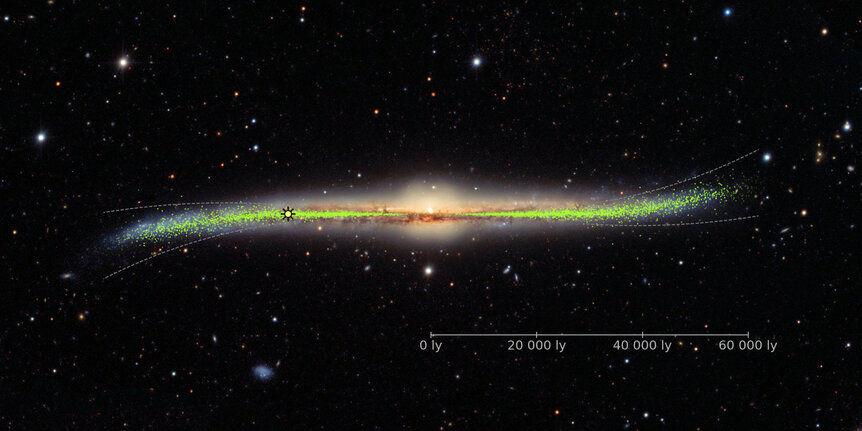Our galaxy is warped!

Astronomers have a weird problem: In many ways, we can map the universe of galaxies around us better than we can the galaxy we live in.
It’s like being stuck inside a room in a house with big windows. You can clearly see lots of other houses outside, but the house you’re inside of is behind the walls, where you can’t see it.
Happily, this analogy only extends so far. We can see lots of things in our galaxy, the Milky Way, enough to get a sense of its shape, size, and structure. But you have to be clever about it.
For example, we know the overall shape is a flat, circular disk, and we’re in that disk near its midplane. We can see that on the sky; if you go outside when the Milky Way is high, you see it as a broad swath of fuzziness stretching across the sky.
We have other techniques to gauge its structure too, including mapping gas clouds (which can be observed with radio telescopes even when those clouds are clear across the galaxy from us) and the apparently very small motion of stars as they orbit the center.
A new study, though, presents a way to see the galaxy using a very old technique updated with modern tech, and I must say it’s really impressive… and more than a little cool.
The method relies on Cepheid variable stars. These are stars that change their brightnesses with regular cycles, getting brighter and dimmer on scales of days to months. The beauty of Cepheids is that way back in 1908, astronomer Henrietta Swan Leavitt discovered that the time it took a Cepheid to go through a brightness cycle was related to its absolute luminosity, the total amount of light it emitted. That’s critical, because we can measure the apparent brightness of a star dimmed by distance. If you know how bright it appears, and how bright it really is, you can calculate its distance.
That, in turn, means that by measuring the time it takes a Cepheid to cycle, you can determine how far away it is. That is the key to the new work. The astronomers used several different sky surveys to observe Cepheids, calculating distances for over 2,400 of them! These stars tend to lie very close to the galactic midplane as well, so they trace out structures in the galaxy in the disk.
One of the most obvious features they found is that the disk is not flat! It’s warped, distorted, like an old vinyl record that’s been lying in the Sun. To be fair, this fact has been known for quite some time, but this new technique is a more direct measurement of it than older methods, which rely on some physical modeling of various phenomena.
They found that the disk is fairly flat from the center of the galaxy out to about 25,000 light years, interestingly (or perhaps just coincidentally) the distance of the Sun from the center of the galaxy as well. Outside this distance the disk warps up on one side of the galaxy and down on the other side all the way out to the edge, some 60,000 light years out from the center. The height of the warp (the deviation from the central midplane) is very roughly 5,000 light years.
The cause of the warp isn’t well understood, but it’s likely to come from gravitational interactions with smaller satellite galaxies orbiting the Milky Way tugging on the disk. It’s also possible the halo of dark matter surrounding the galaxy plays a role as well.
They also found that the disk flares as well. As you go out from the center the disk gets thicker; at the distance of the Sun the thickness is very roughly 700 light years, but farther out it’s three times as thick (from the side, the disk would look a bit like the bell of a trumpet also seen from the side).
But there’s even more! Using various techniques they could get decent measurements of the ages of all the Cepheid stars, and when they mapped them by age they found that stars closer to the galactic center were younger, and older ones farther out. They were also spread out across the sky in obvious structures also delineated by age. This strongly implies that the stars in each of these collections were born around the same time in the same place and were spread out due to galactic rotation. The stars range in age from 20 to 260 million years old, which is pretty young compared to the 12 billion year age of the galaxy itself. These are newcomers to the Milky Way.
To see how this works, the astronomers used a simple physical model of how stars are born and how they move around the galaxy to see if they could match the observations, and they were able to do so pretty easily.
I find this all rather amazing. Not to downplay the amount of work that went into this research, especially historically, but in the end, astronomers looked at a bunch of stars, exploited a well-known fundamental property of them, and then used them to figure out the shape and history of a structure — our galaxy — which is a hundred quadrillion kilometers across.
That, my friends, is cool. That, also, is science.






























